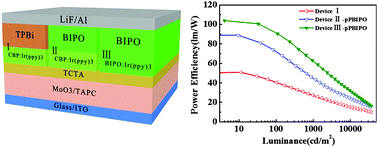Benzimidazole–phosphine oxide hybrid electron transporters for unilateral homogeneous phosphorescent organic light-emitting diodes with enhanced power efficiency†
Abstract
A series of benzimidazole–phosphine oxide hybrids, mNBIPO, mPBIPO, pNBIPO and pPBIPO were developed as electron transporters for Ir(ppy)3-based phosphorescent organic light-emitting diodes. Their energy levels and electron mobilities can be readily regulated through changing the connecting position and the linkage mode. Significantly improved device performance is achieved by replacing TPBi with the new compounds as the electron-transport layer in green PhOLEDs. More interestingly, when pPBIPO was employed as both the electron transporting and host layer, the unilateral homogeneous device exhibited a state-of-the-art device performance, e.g. the maximum EQE and power efficiency reach up to 26.7% and 103.8 lm W−1, respectively. These results clearly demonstrate that utilizing an appropriate electron transporter to construct a simplified unilateral homogeneous device is a promising method to enhance the power efficiency of PhOLEDs.


 Please wait while we load your content...
Please wait while we load your content...